View in other NatureServe Network Field Guides
NatureServe
Montana
Utah
Wyoming
Idaho
Wisconsin
British Columbia
South Carolina
Yukon
California
New York
Smallflower Grass-of-Parnassus - Parnassia parviflora
Other Names:
Parnassia palustris var. parviflora
Native Species
Global Rank:
G5?
State Rank:
S3S4
(see State Rank Reason below)
C-value:
9
Agency Status
USFWS:
USFS:
BLM:
External Links
State Rank Reason (see State Rank above)
Parnassia parviflora occurs primarily in southwestern Montana with a few occurrences in the northwest and northeast. It grows in wetlands, fens, calcareous seeps, and along streams that are (predominately) undisturbed. Population sizes range from being scattered to common though this plant may go unnoticed due to its stature. Revisits to known locations and new surveys are needed to determine current distribution, population sizes, and threats.
- Details on Status Ranking and Review
Range Extent
ScoreF - 20,000-200,000 sq km (~8,000-80,000 sq mi)
Area of Occupancy
ScoreD - 6-25 4-km2 grid cells
Number of Populations
ScoreC - 21 - 80
Environmental Specificity
ScoreA - Very narrow. Specialist or community with key requirements scarce
General Description
PLANTS: Stems mostly solitary, 3–20 cm with a sessile but not clasping, lanceolate to narrowly ovate bract (Lesica et al. 2012).
LEAVES: Leaf blades ovate, 1–3 cm long, tapered to the petiole.
INFLORESCENCE: Terminal, solitary flower (FNA 2016). Calyx lobes purple-tinged, 4–7 mm long, 5-veined, often with a few purple, glandular hairs; petals ovate, 4–7 mm long; staminodia oblong with 5 to 7 capitate lobes. Capsule 5–10 mm long. Lesica (2012) treats this at the specific level (Lesica et al. 2012).
Phenology
Flowers in summer (FNA 2016).
Diagnostic Characteristics
Our treatment follows that of Lesica et al. (2012) in which plants with shorter petals of 4-8 mm and possess 5 veins with a stem bract that is not cordate belong to Parnassia parviflora. Parnassia parviflora has been included in P. palustris by some authors (FNA 2016). Small-flowered plants of P. palustris usually have the staminodes divided into about nine filaments distally and the anthers exceed 1.5 mm, but rarely some plants cannot be clearly assigned to one or other of these species (FNA 2016).
Species Range
Montana Range
Range Descriptions
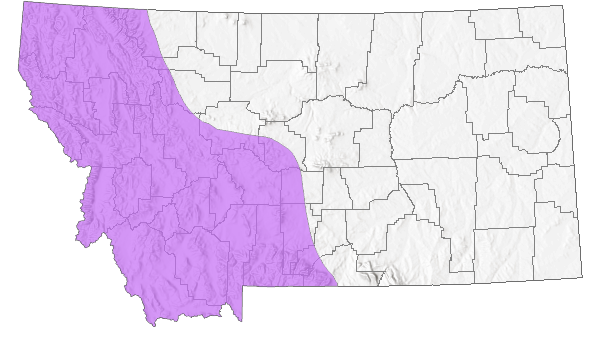
 Native
Native
Range Comments
BC to QC south to CA, ID, MT, SD and MN (Lesica et al. 2012. Manual of Montana Vascular Plants. BRIT Press. Fort Worth, TX).
Observations in Montana Natural Heritage Program Database
Number of Observations: 43
(Click on the following maps and charts to see full sized version)
Map Help and Descriptions
Relative Density
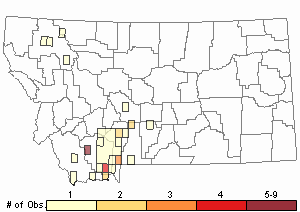
Recency
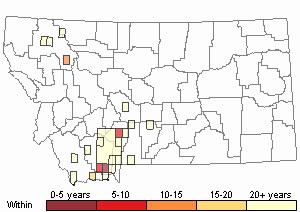

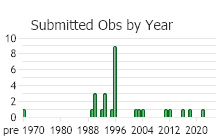
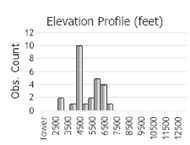 (Observations spanning multiple months or years are excluded from time charts)
(Observations spanning multiple months or years are excluded from time charts)
Habitat
Stewardship Responsibility
References
- Literature Cited AboveLegend:
 View Online Publication
View Online Publication Flora of North America Editorial Committee, eds. 2016. Flora of North America north of Mexico, Vol. 12. Magnoliophyta: Vitaceae to Garryaceae. Oxford University Press, Inc. New York.
Flora of North America Editorial Committee, eds. 2016. Flora of North America north of Mexico, Vol. 12. Magnoliophyta: Vitaceae to Garryaceae. Oxford University Press, Inc. New York. Lesica, P., M.T. Lavin, and P.F. Stickney. 2012. Manual of Montana Vascular Plants. Fort Worth, TX: BRIT Press. viii + 771 p.
Lesica, P., M.T. Lavin, and P.F. Stickney. 2012. Manual of Montana Vascular Plants. Fort Worth, TX: BRIT Press. viii + 771 p.
- Additional ReferencesLegend:
 View Online Publication
View Online Publication
Do you know of a citation we're missing? Culver, D.R. 1994. Floristic analysis of the Centennial Region, Montana. M.Sc. Thesis. Montana State University, Bozeman. 199 pp.
Culver, D.R. 1994. Floristic analysis of the Centennial Region, Montana. M.Sc. Thesis. Montana State University, Bozeman. 199 pp. Jones, W. W. 1901. Preliminary flora of Gallatin County. M.S. Thesis. Bozeman, MT: Montana State College. 78 pp.
Jones, W. W. 1901. Preliminary flora of Gallatin County. M.S. Thesis. Bozeman, MT: Montana State College. 78 pp. Lesica, P., M.T. Lavin, and P.F. Stickney. 2022. Manual of Montana Vascular Plants, Second Edition. Fort Worth, TX: BRIT Press. viii + 779 p.
Lesica, P., M.T. Lavin, and P.F. Stickney. 2022. Manual of Montana Vascular Plants, Second Edition. Fort Worth, TX: BRIT Press. viii + 779 p.
- Web Search Engines for Articles on "Smallflower Grass-of-Parnassus"





